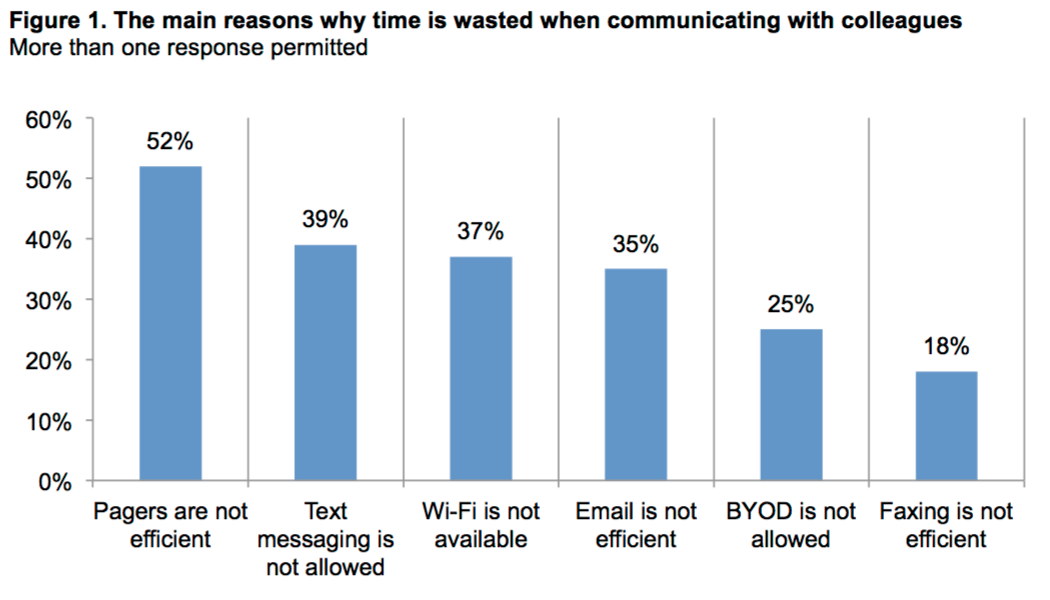
Quick communication among healthcare professionals has always been a challenge. As the Canadian Medical Protective Association points out, “Elements of good communication are sometimes overlooked and this can lead to medico-legal consequences [...] including delays in diagnosis, mishaps in surgery, medication adverse events, and failures in monitoring or follow up of patients.” Good communication not only includes respectful and timely correspondence, but also the security of the information being exchanged.
There are communication gaps between more than just physicians, but also patients and other hospital staff. Implementing and carrying out efficient communication processes is highly complicated and all parties are interrelated.
Hospital Staff Have Difficulty Reaching Physicians
In a hospital, personnel have various codes that signify specific situations and the degree of urgency. What about when a staff member is unable to be reached?
A common difficulty for physicians, nurses and hospital administration is the ability to reach a physician in a timely manner. As the Patient Safety and Quality Healthcare article highlights, “In many organizations, nurses are challenged to identify which physician to contact and the preferred means with which to do so.” Is the number wrong? Is it the right person? Code yellow - missing adult!
A recurring scenario where hospital personnel have difficulty identifying the right physician is when it comes to reaching an on-call physician. One of the reasons is linked to many still struggling with the use of paper on-call schedules. Not only does this method require personnel to contact the hospital’s phone operators who then need to check schedules and faxes to ensure the validity of their information, but it can lead to mistakes and wasted time. Code blue - emergency! Who do we contact? Good question.
According to a Ponemon Report, 52% of respondents feel that the inefficiency of pagers is the top contributor to wasted time, with the second being the dis-allowance of texting in hospitals. The report showed that:
“Respondents also agree that the use of secure text messaging could increase productivity and minimize about half of the economic loss.”

Accurate information concerning which on-call physician to contact is not only hard to get, but the use of various devices also adds to communication difficulties. Reaching the right physician is difficult enough without having different methods to do so. If the physician doesn’t answer, should you send them an email or text? Is there an app for that?

What affects exchanges between physicians lies in the hospital’s ability to find a common ground as to which device to use and its security. Doctors texting one another along with the use of pagers and other technology adds to the diversity of devices, further crippling communication. The bring your own device trend has led to wider communication gaps and privacy leaks. With 2015 being the worst year for cyber attacks, hospitals are putting even more emphasis on ensuring the security of their communication platforms.
Poor Communication Affects Patient Care
The lack of efficient and timely communication when transferring patients between hospital departments and facilities or even during discharge can hinder physician workflow, greatly affecting patients.

A Stanford Medicine Newsletter highlighted that when it comes to patient transfers, “Some communication failures also were a result of distractions, competing priorities or lack of a standardized method for passing along information.” The quality of hospital staff interaction is directly linked to patient safety.
Patient and physician communication is also affected when discharging instructions are not fully understood. The book Hospital Medicine highlights this reality; “Communication gaps are common at the time of hospital discharge, yet physicians and nurses tend to overestimate patients’ comprehension of discharge treatment plans.” Ensuring the patient understands the full picture as to medications, processes and others is essential.
So how do we solve this problem?
Standardizing communication across departments is the most effective solution. Deploying a hospital-wide messaging platform will streamline communication among all staff members, which then translates to better communication for and with patients.

